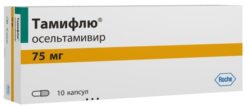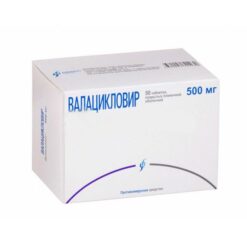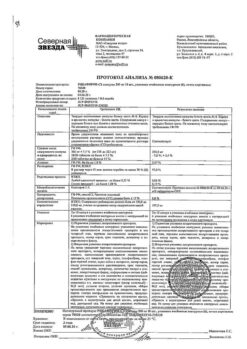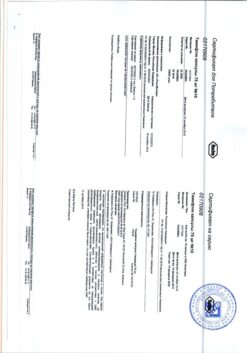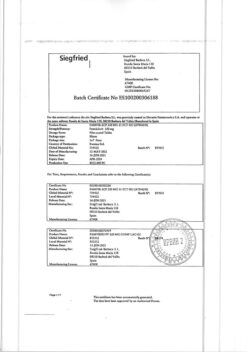Subtotal: €21.74
Rimantadine is an antiviral agent, a derivative of adamantane; it is active against various strains of influenza A virus (especially type A2).
Being a weak base, rimantadine acts by increasing pH of endosomes – membrane vacuoles that surround viral particles after their penetration into the cell. Preventing acidification in these vacuoles blocks the fusion of the viral envelope with the endosome membrane, thus preventing the transfer of viral genetic material into the cell cytoplasm. Rimantadine also inhibits the exit of viral particles from the cell, i.e. it interrupts transcription of the viral genome.
Pharmacokinetics
After oral administration rimantadine is almost completely absorbed in the intestine. Absorption is slow. Binding with plasma proteins is about 40%. Volume of distribution: adults – 17-25 l/kg, children – 289 l/kg. Concentration in nasal secretion is 50% higher than in plasma.
Maximum concentration (Cmax) of active substance in plasma after a single dose of 100 mg once daily is reached after 6 hours and is 181 ng/ml, after 100 mg twice daily – 416 ng/ml. It is metabolized in the liver.
Half-life period is 24-36 hours (T1/2); 75-85% of dose is excreted by kidneys mainly as metabolites, 15% – unchanged. In chronic renal failure the half-life is increased by 2 times. In patients with renal insufficiency and elderly persons can accumulate in toxic concentrations if the dose is not corrected in proportion to the decrease in creatinine clearance (CC).
Indications
Early treatment and prevention of influenza A in adults and children over 7 years of age.
Pharmacological effect
Rimantadine is an antiviral agent, an adamantane derivative; active against various strains of influenza A virus (especially type A2).
As a weak base, rimantadine acts by increasing the pH of endosomes, the membrane-bound vacuoles that surround viral particles after they enter the cell. Preventing acidification in these vacuoles blocks the fusion of the viral envelope with the endosome membrane, thereby preventing the transfer of viral genetic material into the cell cytoplasm. Rimantadine also inhibits the release of viral particles from the cell, i.e. interrupts transcription of the viral genome.
Pharmacokinetics
After oral administration, rimantadine is almost completely absorbed from the intestine. Absorption is slow. The binding to plasma proteins is about 40%. Volume of distribution: adults – 17-25 l/kg, children – 289 l/kg. The concentration in nasal secretions is 50% higher than in plasma.
The maximum concentration (Cmax) of the active substance in the blood plasma after a single dose of 100 mg once a day is reached after 6 hours and is 181 ng/ml, with 100 mg twice a day – 416 ng/ml. Metabolized in the liver.
Half-life – 24-36 hours (T1/2); 75-85% of the dose taken is excreted by the kidneys, mainly in the form of metabolites, 15% – unchanged. In chronic renal failure, the half-life increases by 2 times. In persons with renal insufficiency and in the elderly, may accumulate in toxic concentrations if the dose is not adjusted in proportion to the decrease in creatinine clearance (CC).
Special instructions
Viruses resistant to the drug may emerge.
Prophylactic administration is effective during contacts with sick people, during the spread of infection in closed groups and at a high risk of developing the disease during an influenza epidemic.
When using the drug Rimantadine, exacerbation of chronic concomitant diseases is possible. Elderly patients with arterial hypertension have an increased risk of hemorrhagic stroke. If there is a history of epilepsy and anticonvulsant therapy, the risk of developing a seizure increases with the use of rimantadine. In such cases, the drug Rimantadine is used at a dose of 100 mg/day simultaneously with anticonvulsant therapy.
For influenza caused by virus B, rimantadine has an antitoxic effect.
Impact on the ability to drive vehicles and machinery
Rimantadine does not affect the ability to drive, but persons who experience dizziness, headache, or other central nervous system side effects should use caution.
Active ingredient
Rimantadine
Composition
Active ingredient:
Rimantadine hydrochloride – 50.0 mg
Excipients:
lactose monohydrate – 74.5 mg
potato starch – 24.0 mg
magnesium stearate – 1.5 mg
Pregnancy
The use of Rimantadine is contraindicated during pregnancy and breastfeeding.
Contraindications
Hypersensitivity to rimantadine or any other component of the drug. Acute liver diseases, acute and chronic kidney diseases, thyrotoxicosis, lactase deficiency, lactose intolerance, glucose-galactose malabsorption, pregnancy, breastfeeding period, children under 7 years of age.
With caution
Arterial hypertension, epilepsy (including history), cerebral atherosclerosis, liver failure, elderly patients, gastrointestinal diseases.
Side Effects
From the cardiovascular system: tachycardia, heart failure, heart block (heart rhythm disturbance), palpitations, arterial hypertension, cerebrovascular accident, loss of consciousness.
From the nervous system: insomnia, dizziness, headache, irritability, fatigue, impaired concentration, movement disorders, drowsiness, depressed mood, euphoria, hyperkinesia, tremor, hallucinations, confusion, convulsions.
From the senses: tinnitus, change or loss of smell.
From the respiratory system: shortness of breath, bronchospasm, cough.
From the gastrointestinal tract: nausea, vomiting, loss of appetite, dry oral mucosa, abdominal pain, diarrhea, dyspepsia.
From the skin and subcutaneous tissue: rash.
Other: fatigue.
If you experience the side effects listed in the instructions or they get worse, or you notice any other side effects not listed in the instructions, tell your doctor.
Interaction
Rimantadine reduces the effectiveness of antiepileptic drugs. Adsorbents, astringents and coating agents reduce the absorption of rimantadine. Urine alkalizing agents (acetazolamide, sodium bicarbonate and others) increase the effectiveness of rimantadine due to a decrease in its excretion by the kidneys. Paracetamol and ascorbic acid reduce the maximum plasma concentration of rimantadine by 11%. Cimetidine reduces the clearance of rimantadine by 18%.
If you are using the above or other medications (including over-the-counter medications), consult your doctor before using rimantadine.
Overdose
Symptoms: agitation, hallucinations, arrhythmia. In some cases, when the recommended dose is exceeded, the following are observed: tearing of the eyes and pain in the eyes, increased urination, fever, constipation, sweating, inflammation of the oral mucosa, dry skin.
Treatment: gastric lavage, symptomatic therapy. In case of poisoning, it is necessary to maintain vital functions. Rimantadine is partially eliminated by hemodialysis.
Storage conditions
In a dry place, protected from light, at a temperature not exceeding 25 ° C.
Shelf life
5 years.
Manufacturer
Update of PFC JSC, Russia
| Shelf life | 5 years. |
|---|---|
| Conditions of storage | In a dry, light-protected place at a temperature not exceeding 25 ° C. |
| Manufacturer | Update PFC AO, Russia |
| Medication form | pills |
| Brand | Update PFC AO |
Related products
Buy Rimantadine Reneval, tablets 50 mg 20 pcs with delivery to USA, UK, Europe and over 120 other countries.

